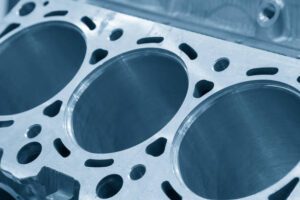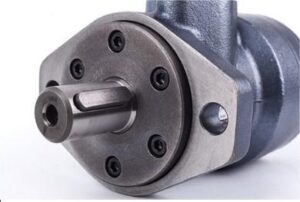Taking the time to secure your ship properly with the best quality of anchor chains will not just save lives offshore, but will also save and protect your investment, hence the reason you should sit back and digest this material for the safety of your marine business. Let’s dive into the details!
Overview of Marine Anchor Chain
An anchor chain is actually a steel chain connecting the hull and anchor. The main function of the anchor chain is to link the anchor and the ship, and transfer the anchor’s holding force to the hull; when anchoring, because the thrown anchor chain has a certain weight.
Once Cargo is loaded onto a ship, it starts floating steadily in the water, upright, or with a practical trim astern. When the ship sails out to sea, it encounters external forces which result in six forms of motions acting on the ship. Without a proper ship anchor chain, these motions become a threat, especially for those ships that require cargo anchor chains.
The force exerted on the anchor by the anchor chain lying flat on the base of the water remains horizontal, which is conducive to the anchor’s reliable grip on the bottom. Simultaneously, this part of the anchor chain can also provide part of the anchoring force due to the blocking effect of the soil.
If the anchor chain is not strong enough then there is no escape of cargo from the behavior of the seas and the wind once they display their rage.
This as a result takes a toll on the loaded cargo, causing damage to other cargo in the vicinity or to the vessel’s structures and fittings and even throwing the cargo overboard. Improper ship anchor chain usage and failure to adhere to the procedures required for cargo storage on ships are dangerous to property, life, and the environment at sea.
To avoid getting into situations like these the responsible personnel on board should be competent enough to prepare and uphold safe carriage of the cargo at all times using anchor chains.
What is an Anchor Chain?
An anchor chain refers to a special chain that links the anchor and the hull and transmits the anchor’s grip. It is often made up of anchor end-chain links, middle-chain links, and end chain links. According to the structure of the chain link, it can be segmented into two types: geared anchor chain and unstacked anchor chain.
The former is stronger than the latter; according to the manufacturing method, the anchor chain can be segmented into cast steel anchor chains and electrically welded anchor chains. The length of the anchor chain is calculated in sections, and the standard length of each section of the anchor chain is 27.5m.
Internodes are linked to the connecting links or connecting shackles. Normally, the chain length of the main anchor on each side of a 10,000-ton ship is about 12 knots.
An anchor chain is ideal for use in marine environments due to its high breaking strength and resistance to abrasion and corrosion. It also allows for simple tension adjustments, ensuring a secure hold on the ship.
Investing in high-quality anchor chains is critical for ensuring cargo transport safety and efficiency, especially in marine environments. In the long run, it is a more cost-effective solution because it has a longer lifespan and requires fewer replacements.
Types of Anchor Chains
Anchor chains can be segmented into two types according to the structure of their chain links: stud chain and studless chain. The chain links of the geared anchor chain are fitted with crossbars.
When the size and material are equal, the strength of the geared chain is greater than that of the chain without gears, the deformation is smaller, and it is not easy to twist when stacked. It is a modern large and medium-sized chain.
Widely employed on ships. The chain link of the unbarred anchor chain has no rungs and is only utilized on small ships. The specification has it that when the diameter of the anchor chain equipped as required does not exceed 17mm, it can be replaced by an unblocked anchor chain with an equal test load, or a steel wire rope or fiber rope with an equal breaking load.
Anchor chains are segmented according to their manufacturing methods, including cast steel anchor chains, welded anchor chains, and forged anchor chains.
Cast steel anchor chain has high strength, good rigidity, small deformation, and wear resistance, horizontal bars are not easy to loosen, have a long service life, and is suitable for mass production. Its disadvantages are complex process, high cost, and poor impact resistance.
The electric welded anchor chain is created of round steel materials that meet the requirements, bent and welded. It has the advantages of advanced and simple production technology, low cost, and good quality.
Although forged anchor chains have good impact resistance and toughness, the manufacturing process is complex, the cost is high, and the quality is unstable.
Currently, welded anchor chains have been most widely used on commercial ships. Anchor chains are almost always fabricated by flash welding, and cast anchor chains are rarely used. Except for the anchor chain accessories, which are mostly forged parts, forged anchor chains have been basically eradicated.
Anchor chain steel grades are used to produce geared anchor chains. Electric welded anchor chains are segmented into three grades: M1, M2, and M3. Cast steel anchor chains are segmented into two grades: M2 and M3.
Adding A (such as AM2) before the corresponding code indicates a chain with gears, and B indicates a chain without gears (there are two levels, BM1 and BM2). The greater the grade of steel, the greater the tensile strength.
AM1 grade anchor chain steel is killed steel, AM2 and AM3 grade anchor chain steel are completely killed and fine-grained steel. For the same ship, if stronger steel is employed, the chain link size can be appropriately reduced.
However, the U3 Anchor chain is made of low-carbon alloy steel and is manufactured on automatic chain-making machines with flash butt welded joints.
At the end of the manufacturing process, all sizes chains are heat treated and proof load tested. Each length is marked with a unique identification number on the end link for traceability and is typically supplied in 27.5m lengths.
Used as a ship’s anchor chain in permanent mooring systems or as a ground chain within a mooring system, its chain diameters range from 14mm to 60mm, with a black bitumen coating as standard, but a hot dip galvanized finish is also available (larger sizes available upon request).
Classification: L.R. classification is standard (other third-party classification is available upon request). On request, bespoke assemblies can be produced. Supplied in standard 27.5m shot lengths or to customer specifications.
BV Marine Classification and Inspection
Bureau Veritas Marine is concerned about the safety and efficiency of shipowners and operators because any inadequate safety management can result in the loss of life, cargo, and reputation. Additionally, inadequate design, construction, and operation can lead to high operating costs, increased fuel consumption, and a shorter operating life.
Therefore classifying marine assets with a reputable classification society such as Bureau Veritas ensures that vessels remain safe, compliant, and environmentally friendly throughout their operational lives. Vessels operate in harsh environments and must adhere to stringent safety regulations.
Vessel classification is used by ship owners and operators to help them secure a license to operate, control and reduce safety and security risks, comply with stringent regulations, and improve efficiency and environmental performance.
As one of the largest classification societies, their experience ensures that your vessels comply with international regulations.
Their extensive regulatory knowledge and cutting-edge research ensure that your vessels are built to the highest standards. Geographic convenience and accessibility are provided by their global network of +2,000 highly qualified surveyors.
Their industry-leading tools and services provide owners who choose BV class with timely and cost-effective solutions. They are a founding member of IACS (International Association of Classification Societies) and one of the leading classification societies.
BV Strict Procedures for Anchor Chain Usage
There are several BV procedures that must be followed in order to properly secure a container onto a vessel and ensure a safe and secure voyage. The procedures involved in ship container chain lashing are as follows:
1. Check that the vessel has been properly prepared for transportation. This includes checking that the anchor chain hook points are in good condition and that the lashings themselves are the correct length and thickness.
2. After the vessel has been prepared, the container is placed directly on the ship’s deck.
3. The container must then be secured using ship-recommended equipment like the anchor chain which links the anchor and the ship, and transfers the anchor’s holding force to the hull; when anchoring, because the thrown anchor chain has a certain weight.
4. After securing the ship anchor chains, the final step is to inspect the entire assembly to ensure that everything is done correctly and that there are no potential problems that could cause problems during transit.
BV Safety Tips for Marine Trips
Here are a few important things to keep in mind when securing your ship. If you follow these BV guidelines, your cargo will be safe for the duration of the sea voyage. Let’s dive into it:
1. Ship anchor chains must be checked thoroughly and tightened while on a passage.
2. The underlying anchor chains should be sufficient to keep the loads from moving when the ship rolls through 30 degrees in 13 seconds.
3. Tightening the cargo down to the ship with Lashing equipment will help a lot in completely securing it before it shifts.
4. Integration of different material components with varying strengths and elasticity should be avoided at all costs.
In conclusion, marine anchor chains if done properly will save lives and your investment onboard, saving your business billions of dollars. We hope this post helps. Good luck!






